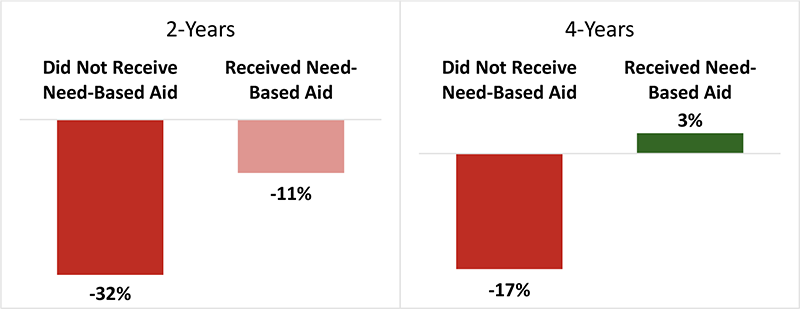WSAC Research Digest #2: Enrollment

This is the second of the series of WSAC Research Digests that highlight interesting data insights and takeaways from WSAC’s new Strategic Action Plan (SAP) Dashboard. The goal of the series is to communicate and interpret data in a brief and informal manner to surface important education issues in the state.
It’s no secret that postsecondary enrollment has declined since the COVID-19 pandemic. In fact, there were about 80,000 fewer undergraduate students enrolled in Washington in 2021-2022 than there were before the start of the pandemic, amounting to a 17 percent drop in enrollment. But the SAP Dashboard also calls out one of the state’s bright spots: pandemic enrollment declines were tempered for students who received need-based financial aid.
Let’s compare enrollment for undergraduate, degree-seeking students at public institutions in fall 2019 with enrollment in fall 2022, grouped by whether or not they received need-based financial aid. (Note that the definition of need-based aid recipients varies slightly for 2-year and 4-year institutions.)
Enrollment for students at 2-years who received need-based aid dropped by 11 percent over the three-year pandemic period, compared to a 32 percent drop for students who did not receive need-based aid. At 4-years, enrollment for need-based aid recipients actually increased by 3 percent over the three-year period, compared to a 17 percent drop in enrollment for students who did not receive need-based aid. This seems to suggest that financial aid was a boon for students during the pandemic enrollment slump.

Importantly, there was also a shift in the state’s financial aid policy at the onset of the pandemic that likely contributed to these trends. In the 2020-21 academic year, Washington implemented the Washington College Grant (formerly the State Need Grant) that expanded eligibility for the largest need-based state financial aid program to more students. The eligibility expansion might have helped to offset the negative enrollment impacts of the COVID-19 pandemic by increasing the number of students who had access to aid.
A closer look at the year-over-year changes at 2-year institutions shows some volatility—an enrollment dip in fall 2021 and then a subsequent rebound in fall 2022 for need-based aid recipients. Sources from SBCTC tell us that this is likely a combination of pandemic disruptions, Washington College Grant expansion, and the rollout of a new data system that shifted the method of defining “economically disadvantaged” status.
The takeaway: a greater proportion of students enrolled at public institutions in Washington are receiving need-based aid than before the pandemic. This is likely because of expanded eligibility for the Washington College Grant, a critical resource for postsecondary education in our state. As the state continues to recover from pandemic-induced enrollment decline, the Washington College Grant and other aid programs can help boost enrollment and support students along their education journey.
Start exploring: https://wsac.wa.gov/sap-dashboard
 Skip to main content
Skip to main content


